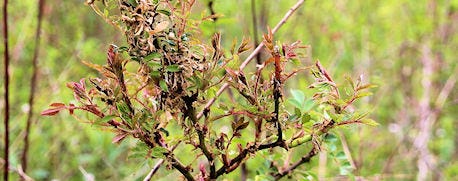September 18, 2013

Multiflora rose has long been the invasive scourge of Eastern pastures and woodlands. And now, an invasive disease called rose rosette disease is attacking and killing multiflora rose across much of the country.
Landowners and managers who have battled multiflora rose for years are celebrating, while rose growers are lamenting, says Jim Finley, forest management expert at Penn State University. "Depending on your perspective, it's either a good thing or a bad thing."

A BEAUTIFUL SIGHT? Beauty is in the eye of the beholder – and the type of rose. This multiflora rose bush is being killed by rose rosette disease.
RRD has spread across most of the country, except in the Missisippi River Delta. In the east, RRD has reared its ugly fungus across the Mid-Atlantic. USDA's Agricultural Research Service reports it has been found in Somerset County, N.J., and even in New York City's Brooklyn Botanical Garden.
How to spot RRD
The disease is typically recognized by a rapid elongation of new shoots, which often form clusters of small branches or "witches brooms," explains Finley. The leaves on these brooms are often small, distorted and red in coloration. The canes where brooms occur often will be soft and pliable. Even the thorns have these characteristics, at least for a while.
Flowers on these canes also may display deformities. Infected plants often die in one or two years; some, however, may live up to four years.
The disease is spread by a mite or by grafting – as in the case of horticultural rose varieties. Mite populations build through summer, becoming most abundant in September.
And now the bad news
Cultivated roses are at risk of being infected by mites flying downwind from infected multiflora rose, says Finley. Once infected, symptoms show up in less than four weeks. There's no treatment or cure.
While some landowners will celebrate the decline of multiflora rose, the benefit of its death may be greatly exaggerated. It's reason to reduce vigilance, warns Finley.
"The void left by its demise may be rapidly filled by bush honeysuckle and, perhaps, autumn or Russian olive – other invasive plants," he adds. "If you want to keep invasive plant species at bay on your land, the sooner you act the better. It's much easier to control a few."
You May Also Like




